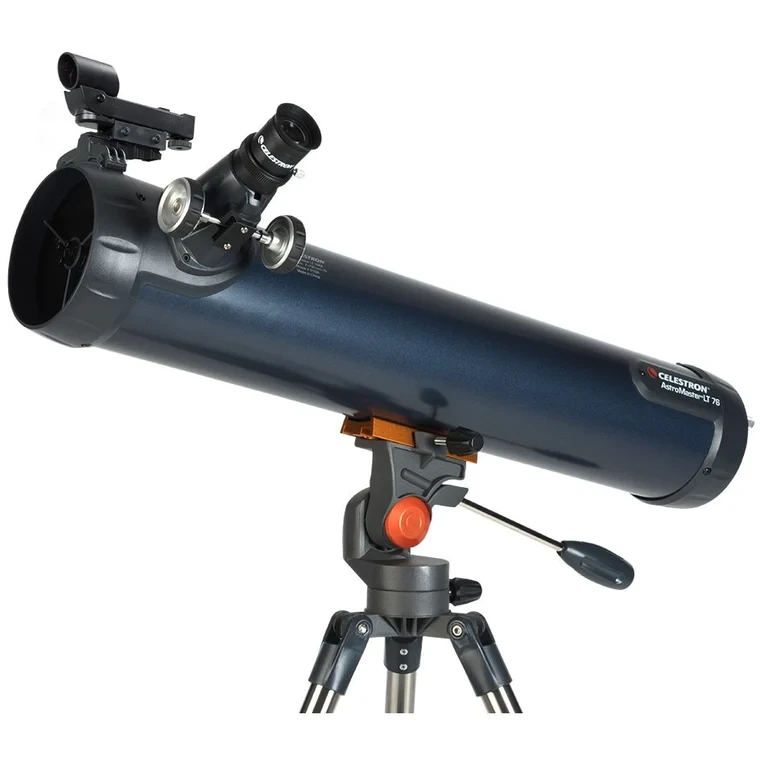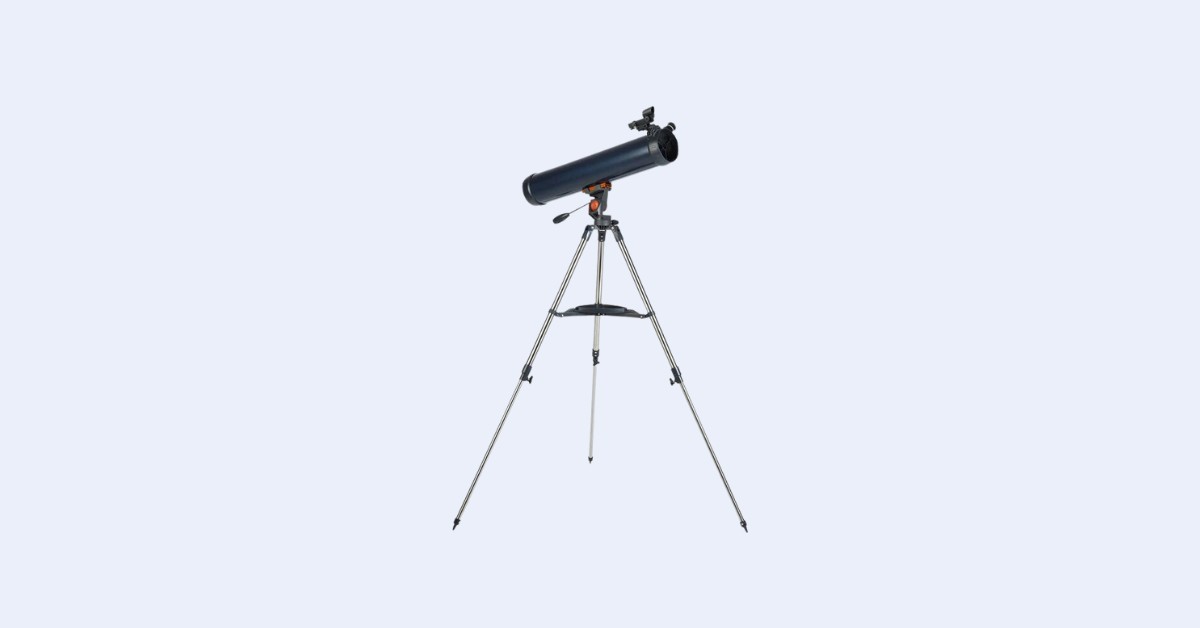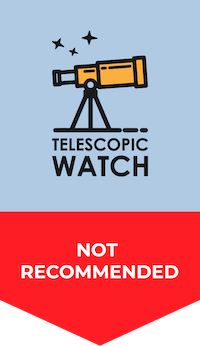The Optical Tube
The Celestron AstroMaster LT 76AZ is a 76mm (3”) f/9.2 Newtonian reflector with a focal length of 700mm. Its primary mirror is spherical, but this isn’t an issue due to its long focal ratio and small size. A larger, faster telescope that uses a spherical primary mirror, such as the 130mm f/5 Celestron AstroMaster 130 EQ or a typical 76mm f/4 tabletop reflector, would suffer from a lack of sharpness and definition; however, in the case of the 76mm f/9 sphere that comes with the AstroMaster LT 76AZ, any deviation from a parabola is insignificant, and thus it offers great performance for astronomical purposes.

Despite this optically advantageous design, however, light loss caused by both mirrors and the secondary mirror’s obstruction in the 76AZ results in it having no better performance in light gathering or resolving power than a puny 60mm refractor; yet even still, it presents several advantages over one, including no chromatic aberration and its shorter focal length that allows for a wider field of view and lower power viewing with given eyepieces. In addition to these benefits, collimation of the AstroMaster 76AZ is easy because of its long focal ratio, though you will have to provide your own tools since none are included with the scope.
The focuser on the AstroMaster LT 76AZ is a fairly standard 1.25” plastic rack-and-pinion, which is acceptable for a slow f/9 instrument. Many of the other fittings on the tube, such as the castings at the ends of the tube and the spider holding the secondary mirror in place, are plastic, so you need to be especially careful not to smack the telescope into anything, as repair or replacement of damaged plastic parts is next to impossible.
The AstroMaster LT 76AZ attaches to its mount with a very short Vixen-style dovetail rail bolted directly to the bottom of the optical tube. The dovetail is too short to allow you to slide the scope to adjust balance, and the lack of any rings means the angle of the focuser is fixed. Realistically, attempting to use the dovetail to attach the LT 76AZ to a different mount would result in uncomfortable angles for the eyepiece, potentially making it downright unusable.
Accessories
The Celestron AstroMaster LT 76AZ reflector telescope includes a pair of three-element eyepieces offering a 50-degree apparent field of view—a 20mm for 45x and a 10mm for 90x. There are better eyepieces for sure, but both of the supplied oculars are acceptable in quality and feature glass optics and plenty of eye relief, which unfortunately are not always a given with such a low-priced scope. You will probably not need any other eyepieces for the LT 76AZ.
The AstroMaster LT 76AZ comes with a generic battery-powered “StarPointer” red dot sight to aim the telescope. Although this finder is great, the bracket used to attach it to the telescope is not very stiff and can become deformed or warped over time. This issue stems from Celestron jerry-rigging the StarPointer to replace an earlier, low-quality sight that was originally on the AstroMaster telescopes. When correctly aligned with the 76AZ, the red dot finder makes aiming a breeze; however, if you are unable to align it due to its shoddy construction, using this telescope becomes even more frustrating when combined with its lack of fine adjustment capability on the mount.
The AstroMaster AZ Mount
The Celestron AstroMaster AZ telescopes all use the same mount, which shares much of its design with the EQ versions’ CG-3 mount and tripod, the only difference being the design of the mount head. It attaches to the LT 76AZ optical tube and other tubes with a standard Vixen-style dovetail saddle. The parts are a mix of cheap, fragile metal alloy castings and a huge amount of plastic parts, even in crucial places like the fasteners and clamps for the tripod legs.
The AstroMaster AZ mount head is a simple alt-azimuth design, much like a basic photo tripod pan head that allows movement up-down and left-right, with the only adjustment control being a handle to lock the altitude axis and a simple lever/brake clutch for the azimuth axis. Unfortunately, I find this lack of fine adjustment controls on the AstroMaster AZ mount head makes it unsuitable for telescopes designed primarily for viewing the Moon and planets like the AstroMaster LT 76AZ. In using the LT 76AZ, I often find the top-heavy, unbalanced nature of such a mount design when paired with long optical tubes inherently unbalances and torques the mount either down or up when aimed, which renders it nearly impossible to keep in place without locking down most or all of the altitude axis. As such, using it is extremely frustrating at even fairly low magnifications, as you will either overshoot your target or watch it slowly drift out of view as the scope droops in altitude.
Should I buy a Used Celestron AstroMaster LT 76AZ?
In my opinion, there is little point in buying a used Celestron AstroMaster LT 76AZ reflector, given its complete lack of capabilities, even if it’s in good shape; you could DIY or obtain a better mount, but doing so would cost as much as simply buying a better telescope. The plastic parts of the scope are also very easily damaged.
Alternative Recommendations
The AstroMaster LT 76AZ is far from our top pick in its price range or for a beginner telescope in general. Here are a few alternatives we recommend instead:
Under $200
- The Zhumell Z100/Orion SkyScanner 100 vastly outperforms the AstroMaster LT 76AZ with its larger aperture and wider field of view, along with similar provided accessories and a sturdy, easy-to-aim tabletop Dobsonian mount.
- The SarBlue Mak60 tabletop Dobsonian mount offers similar performance to the AstroMaster LT 76AZ but in a much more compact package with a steadier mount to boot.
- The Orion SpaceProbe II 76EQ features the same optics and performance as the AstroMaster LT 76AZ but a decent (albeit still not ideal) mount at a slightly lower price too.
$200-$350
- The Sky-Watcher Heritage 150P has double the aperture of the AstroMaster LT 76AZ with vastly superior light-gathering and resolving power, as well as an easy-to-use tabletop Dobsonian mount, collapsible tube for portability, and quality included accessories.
- The Sky-Watcher Heritage 130P has much larger aperture than the AstroMaster LT 76AZ with the same conveniences of the larger 150P such as its tabletop mount and collapsible tube, though it’s not much more compact than the 150P so we’d recommend the larger model if you can afford it.
- The Orion StarBlast 4.5 Astro offers slightly better performance than smaller 100mm tabletop reflectors and vastly outpaces the Astromaster LT 76AZ, without the complexity of a collapsible tube as in the Sky-Watcher Heritage scopes.
Aftermarket Accessory Recommendations
There is pretty much no point in buying additional accessories for the AstroMaster LT 76AZ. It will eat into the budget for a better instrument, and the scope is limited in handling higher magnifications by its diminutive size and the poor quality of its mount. A 32mm Plossl eyepiece (28x) provides a wider true field of view and lower power than the stock 20mm unit. While somewhat unnecessary and expensive, it can be used with other telescopes later on, so it may not be a bad investment.
What can you see?
The meager aperture of the Celestron AstroMaster LT 76AZ means that it is severely limited for deep-sky viewing. Globular clusters, planetary nebulae, and galaxies all appear as detail-less “faint fuzzies” if you can see them at all, with only a few exceptions, while larger open star clusters struggle to fit in the scope’s fairly narrow field of view with the stock 20mm ocular at 45x. The brightest emission nebulae, like the Lagoon (M8) and Orion Nebula (M42), look good provided you can escape the worst light pollution conditions, though they pale in comparison to the views through a larger instrument under dark skies. Plenty of double stars can be resolved with the LT 76AZ but you may have a hard time finding them or keeping them in the field of view, especially at higher magnifications.
The Astromaster LT 76AZ is limited by its small aperture, but its sharp optics do a good job on the Moon and planets. You can see the phases of Venus and Mercury – though the latter can prove challenging – as well as the polar ice caps and possibly a couple of dark markings on Mars when the planet reaches its closest distance to Earth. The Moon shows jaw-dropping detail, while Jupiter’s cloud belts, Great Red Spot, and four Galilean moons can be seen – though the disks and shadows of the moons can be hard to resolve even during a transit. Saturn’s rings and possibly the Cassini Division within them can be seen, along with stripes on Saturn and a few of its moons. Uranus and Neptune are merely fuzzy dots, barely distinguishable from stars if at all, and with moons far too dim to see with such a small scope. Pluto is similarly out of reach without a vastly larger instrument than the LT 76AZ on account of its dimness.



